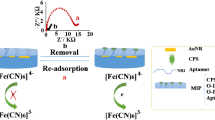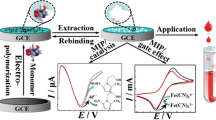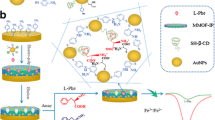Abstract
We report on an electrode for the amperometric determination of lorazepam. A glassy carbon electrode was coated with a molecular imprint made by electropolymerization of ortho-phenylenediamine and filled with multiwalled carbon nanotubes and gold nanoparticles, which enhances the transmission of electrons. The sensor was studied with respect to its response to hexacyanoferrate (III) as a probe and by electrochemical impedance spectroscopy, cyclic voltammetry and square wave voltammetry. The linear response range to Lorazepam is from 0.5 nM to 1.0 nM and from 1.0 nM to 10.0 nM, with a detection limit of 0.2 nM (at an S/N of 3). The electrode was successfully applied to determine Lorazepam in spiked human serum.

The preparation of schematic of the AuNP/MIP/f−MWCNT/GCE electrode






Similar content being viewed by others
References
Kazemifard AG, Gholami K, Dabirsiaghi A (2006) Optimized determination of Lorazepam in human serum by extraction and high-performance liquid chromatographic analysis. Acta Pharm 56:481–488
Kondo T, Buss DC, Routledge PA (1993) A method for rapid determination of Lorazepam by high-performance liquid chromatography. Ther Drug Monit 15:35–38
Gunawan S, Walton NY, Treiman DM (1990) Analysis of Lorazepam in rat brain using liquid/liquid and solid-phase extraction in combination with high performance liquid chromatography. Biomed Chromatogr 4:168–170
Pistos C, Stewart JT (2003) Direct injection HPLC method for the determination of selected benzodiazepines in plasma using a Hisep column. J Pharm Biomed Anal 33:1135–1142
Ghasemi J, Niazi A (2005) Two- and three-way chemometrics methods applied for spectrophotometric determination of Lorazepam in pharmaceutical formulations and biological fluids. Anal Chim Acta 533:169–177
Pichini S, Pacifici R, Altieri I, Palmeri A, Pellegrini M, Zuccaro P (1999) Determination of Lorazepam in plasma and urine as trimethylsilyl derivative using gas chromatography-tandem mass spectrometry. J Chromatogr B732:509–514
Zapardiel A, López JP, Bermejo E, Hernández L, Valenciano MJ (1990) Determination of Lorazepam in human urine by adsorptive stripping voltammetry. Microchem J 41:10–21
Lee XP, Kumazawa T, Sato J, Shoji Y, Hasegawa C, Karibe C, Arinobu T, Seno H, Sato K (2003) Simple method for the determination of benzodiazepines in human body fluids by high-performance liquid chromatography–mass spectrometry. Anal Chim Acta 492:223–231
Wulff G, Sarhan A, Zabrocki K (1973) Enzyme-analogue built polymers and their use for the resolution of race mates. Tetrahed Lett 14:4329–4332
Vlatakis G, Andersson LI, Müller R, Mosbach K (1993) Drug assay using antibody mimics made by molecular imprinting. Nature 361:645–647
Andersson LI (2000) Molecular imprinting for drug bioanalysis: a review on the application of imprinted polymers to solid-phase extraction and binding assay. J Chromatogr B 739:163–173
Feng L, Liu Y, Tan Y, Hu J (2004) Biosensor for the determination of sorbitol based on molecularly imprinted electrosynthesized polymers. Biosens Bioelectron 19:1513–1519
Wu X (2012) Molecular imprinting for anion recognition in aqueous media. Microchim Acta 176:23–47
Zhang J, Wang Y, Lv R, Xu L (2010) Electrochemical tolazoline sensor based on gold nanoparticles and imprinted poly-o-aminothiophenol film. Electrochim Acta 55:4039–4044
Kan X, Zhao Q, Zhang Z, Wang Z, Zhu J (2008) Molecularly imprinted polymers microsphere prepared by precipitation polymerization for hydroquinone recognition. Talanta 75:22–26
Hart BR, Shea KJ (2001) Synthetic peptide receptors: molecularly imprinted polymers for the recognition of peptides using peptide-metal interactions. J Am Chem Soc 123:2072–2073
Tom LA, Gerard CL, Hutchison CM, Brooker AS (2012) Development of a novel molecularly imprinted polymer for the retention of 4,6-dimethyldibenzothiophene. Microchim Acta 176:375–380
Hsu C, Lin H, Thomas JL, Wu B, Chou T (2006) Incorporation of styrene enhances recognition of ribonuclease A by molecularly imprinted polymers. Biosens Bioelectron 22:355–363
Li H, Liu Y, Zhang Z, Liao H, Nie L, Yao S (2005) Separation and purification of chlorogenic acid by molecularly imprinted polymer monolithic stationary phase. J Chromatogr A 1098:66–74
Moreira FTC, Freitas VAP, Sales MGF (2011) Biomimetic norfloxacin sensors made of molecularly-imprinted materials for potentiometric transduction. Microchim Acta 172:15–23
Kan X, Zhao Y, Geng Z, Wang Z, Zhu J (2008) Composites of multiwalled carbon nanotubes and molecularly imprinted polymers for dopamine recognition. J Phys Chem C 112:4849–4854
Chen P, Nien P, Hu C, Ho K (2010) Detection of uric acid based on multi-walled carbon nanotubes polymerized with a layer of molecularly imprinted PMAA. Sens Actuators B Chem 146:466–471
Zhang Z, Hu Y, Zhang H, Yao S (2010) Novel layer-by-layer assembly molecularly imprinted sol–gel sensor for selective recognition of clindamycin based on Au electrode decorated by multi-wall carbon nanotube. J Colloid Interface Sci 344:158–164
Wang H, Zhao H, Quan X, Chen S (2011) Electrochemical determination of tetracycline using molecularly imprinted polymer modified carbon nanotube-gold nanoparticles electrode. Electroanalysis 23:1863–1869
Wang J, Timchalk C, Lin YH (2008) Carbon nanotube-based electrochemical sensor for assay of salivary cholinesterase enzyme activity: an exposure biomarker of organophosphate pesticides and nerve agents. Environ Sci Technol 42:2688–2693
Xie CG, Li HF, Li SQ, Wu J, Zhang ZP (2010) Surface molecular self-assembly for organophosphate pesticide imprinting in electropolymerized poly(p-aminothiophenol) membranes on a gold nanoparticle modified glassy carbon electrode. Anal Chem 82:241–249
Blanco-Lopez MC, Lobo-Castanon MJ, Miranda-Ordieres AJ, Tunon-Blanco P (2004) Electrochemical sensors based on molecularly imprinted polymers. Trends Anal Chem 23:36–48
Kan X, Liu T, Zhou H, Li C, Fang B (2010) Molecular imprinting polymer electrosensor based on gold nanoparticles for theophylline recognition and determination. Microchim Acta 171:423–429
Aghaei A, Hosseini MRM, Najafi M (2010) A novel capacitive biosensor for cholesterol assay that uses an electropolymerized molecularly imprinted polymer. Electrochim Acta 55:1503–1508
Song W, Chen Y, Xu J, Yang XR, Tian DB (2010) Dopamine sensor based on molecularly imprinted electrosynthesized polymers. J Solid State Electrochem 14:1909–1914
Xie C, Gao S, Guo Q, Xu K (2010) Electrochemical sensor for 2,4-dichlorophenoxy acetic acid using molecularly imprinted polypyrrole membrane as recognition element. Microchim Acta 169:145–152
Frens G (1973) Controlled nucleation for the regulation of the particle size in monodisperse gold suspensions. Nat Phys Sci 241:20–22
Liu S, Li Y, Li J, Jiang L (2005) Enhancement of DNA immobilization and hybridization on gold electrode modified by nanogold aggregates. Biosens Bioelectron 21:789–795
Acknowledgments
We wish to express our gratitude to the research Affairs Division and Research Council of Isfahan University of Technology (IUT) and Center of Excellency in Sensor and Green Chemistry for financial support of this work.
Author information
Authors and Affiliations
Corresponding author
Electronic supplementary material
Below is the link to the electronic supplementary material.
ESM 1
(DOCX 59 kb)
Rights and permissions
About this article
Cite this article
Rezaei, B., Rahmanian, O. & Ensafi, A.A. Sensing Lorazepam with a glassy carbon electrode coated with an electropolymerized-imprinted polymer modified with multiwalled carbon nanotubes and gold nanoparticles. Microchim Acta 180, 33–39 (2013). https://doi.org/10.1007/s00604-012-0897-z
Received:
Accepted:
Published:
Issue Date:
DOI: https://doi.org/10.1007/s00604-012-0897-z




